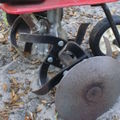Cultivator
A cultivator is a piece of agricultural equipment used for secondary tillage. One of its primary purposes is to stir the soil around crops to promote growth and control weeds. Soil cultivation involves both stirring and pulverizing the soil, either before planting to aerate the soil and prepare a smooth, loose seedbed, or after the crop has begun growing to kill weeds—controlled disturbance of the topsoil close to the crops to promote growth and destroy weeds. Unlike a harrow, which disturbs the entire surface of the soil, cultivators are designed to disturb the soil in careful patterns, sparing the crop plants but disrupting the weeds.
Cultivators vary widely in size and shape, from small, hand-held devices to large, heavy machinery. The type of cultivator used depends largely on the scale of the farming operation and the nature of the soil and crop.
Types of Cultivators
There are several types of cultivators, each designed for specific tasks:
- Hand Cultivator: A small, hand-held tool used for garden and small-scale farming. It is ideal for weeding and aerating soil around plants.
- Tine Cultivator: Features several long, curved tines or teeth. It is pulled behind a tractor, stirring the soil to a specific depth.
- Rotary Cultivator: Also known as a rototiller, it includes rotating blades that churn the soil. It can be either self-propelled or towed behind a tractor.
- Row Crop Cultivator: Designed for cultivating between rows of plants. It often has adjustable arms to fit different row widths and may include shields to protect young plants from the disturbed soil.
Uses and Benefits
Cultivators are used for various purposes, including:
- Weed Control: By disturbing the soil, cultivators can kill existing weeds and prevent weed seeds from germinating.
- Soil Aeration: Cultivating increases the soil's oxygen content, which is beneficial for plant roots.
- Water Conservation: Loose soil allows rainwater to penetrate more deeply, reducing runoff and conserving water.
- Fertilizer Incorporation: Cultivators can mix fertilizers into the soil, improving nutrient availability to plants.
Environmental Impact
While cultivators can improve crop production, their use must be managed carefully to prevent soil erosion, loss of organic matter, and disruption of soil structure. Over-cultivation can lead to negative environmental impacts, such as increased susceptibility to erosion.
Innovations in Cultivation Technology
Advancements in agricultural technology have led to the development of precision cultivators that can target weeds very close to crops, minimizing damage to the plants. GPS and sensor technology allow for more accurate cultivation, reducing the need for chemical weed control and supporting sustainable farming practices.
See Also
This article is a agriculture stub. You can help WikiMD by expanding it!
Transform your life with W8MD's budget GLP-1 injections from $125.
W8MD offers a medical weight loss program to lose weight in Philadelphia. Our physician-supervised medical weight loss provides:
- Most insurances accepted or discounted self-pay rates. We will obtain insurance prior authorizations if needed.
- Generic GLP1 weight loss injections from $125 for the starting dose.
- Also offer prescription weight loss medications including Phentermine, Qsymia, Diethylpropion, Contrave etc.
NYC weight loss doctor appointments
Start your NYC weight loss journey today at our NYC medical weight loss and Philadelphia medical weight loss clinics.
- Call 718-946-5500 to lose weight in NYC or for medical weight loss in Philadelphia 215-676-2334.
- Tags:NYC medical weight loss, Philadelphia lose weight Zepbound NYC, Budget GLP1 weight loss injections, Wegovy Philadelphia, Wegovy NYC, Philadelphia medical weight loss, Brookly weight loss and Wegovy NYC
|
WikiMD's Wellness Encyclopedia |
| Let Food Be Thy Medicine Medicine Thy Food - Hippocrates |
Medical Disclaimer: WikiMD is not a substitute for professional medical advice. The information on WikiMD is provided as an information resource only, may be incorrect, outdated or misleading, and is not to be used or relied on for any diagnostic or treatment purposes. Please consult your health care provider before making any healthcare decisions or for guidance about a specific medical condition. WikiMD expressly disclaims responsibility, and shall have no liability, for any damages, loss, injury, or liability whatsoever suffered as a result of your reliance on the information contained in this site. By visiting this site you agree to the foregoing terms and conditions, which may from time to time be changed or supplemented by WikiMD. If you do not agree to the foregoing terms and conditions, you should not enter or use this site. See full disclaimer.
Credits:Most images are courtesy of Wikimedia commons, and templates, categories Wikipedia, licensed under CC BY SA or similar.
Translate this page: - East Asian
中文,
日本,
한국어,
South Asian
हिन्दी,
தமிழ்,
తెలుగు,
Urdu,
ಕನ್ನಡ,
Southeast Asian
Indonesian,
Vietnamese,
Thai,
မြန်မာဘာသာ,
বাংলা
European
español,
Deutsch,
français,
Greek,
português do Brasil,
polski,
română,
русский,
Nederlands,
norsk,
svenska,
suomi,
Italian
Middle Eastern & African
عربى,
Turkish,
Persian,
Hebrew,
Afrikaans,
isiZulu,
Kiswahili,
Other
Bulgarian,
Hungarian,
Czech,
Swedish,
മലയാളം,
मराठी,
ਪੰਜਾਬੀ,
ગુજરાતી,
Portuguese,
Ukrainian
Contributors: Prab R. Tumpati, MD








